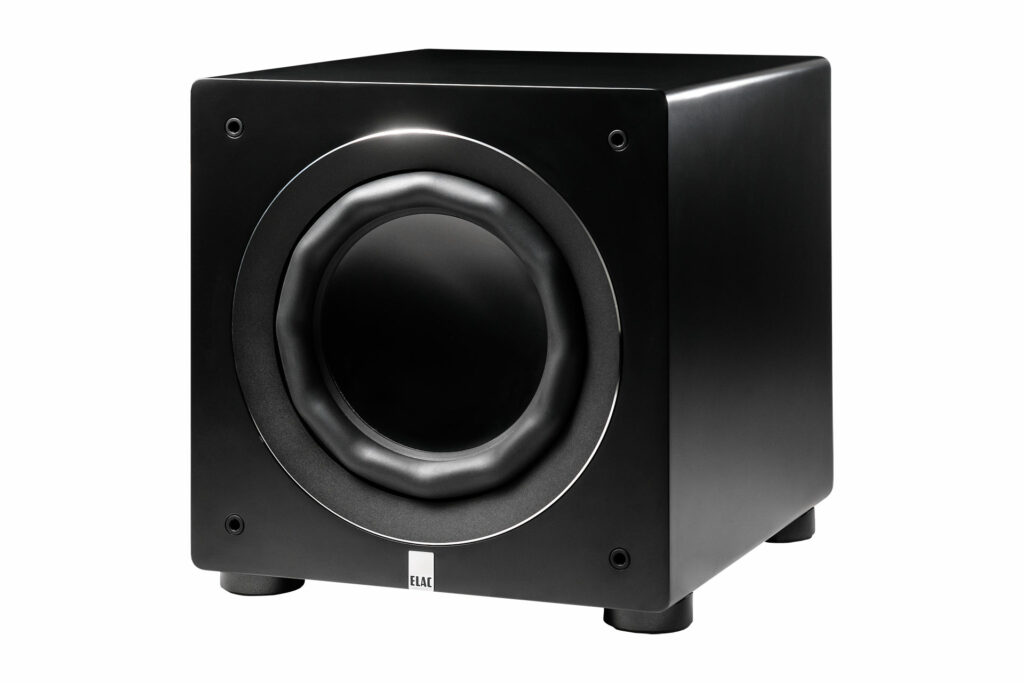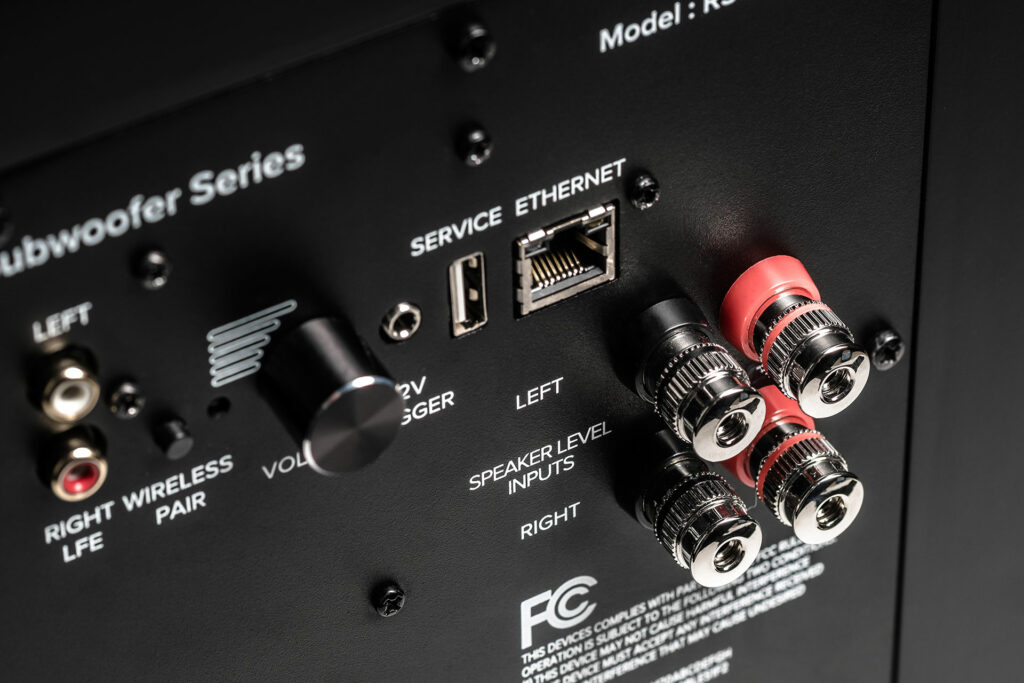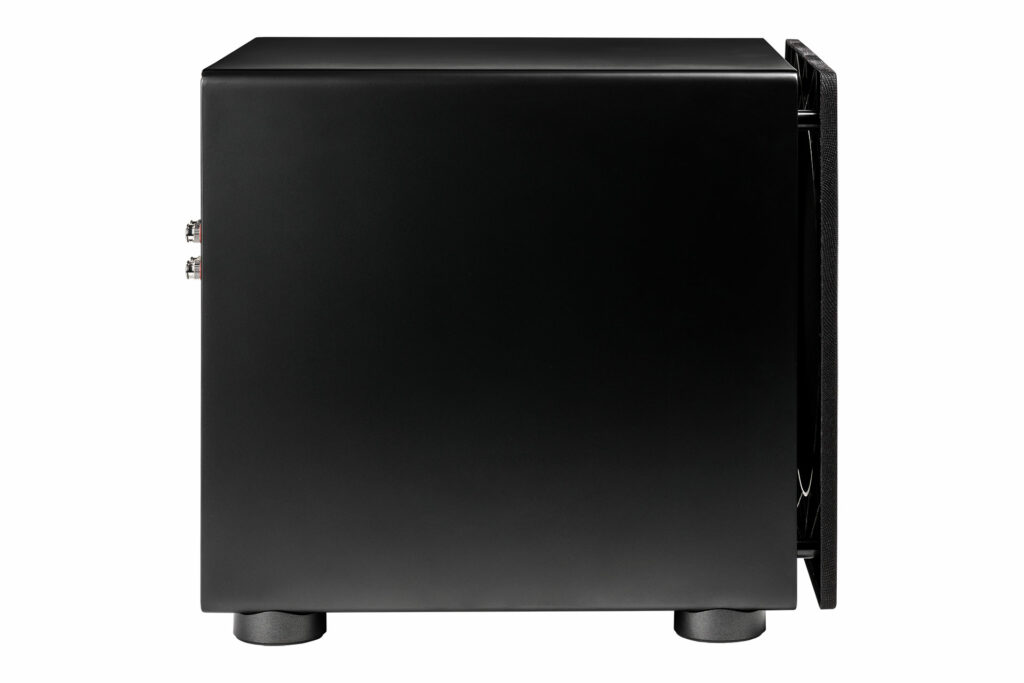Although many loudspeakers are marketed as full-range, in reality only a minority actually go deep enough to rightfully deserve such a moniker. To achieve a truly full-range audio system using less than full-range loudspeakers requires a subwoofer to produce frequencies below 80Hz. Subwoofers also offer far more placement options than a full-range pair of loudspeakers, which must be located where they image best and produce the most linear in-room frequency response. This position is not often the ideal place for supporting good in-room bass. The solution is a rock-solid subwoofer.
Part of ELAC’s Varro line of subwoofers, the ELAC Varro Reference RS500 (buy at Crutchfield) is designed to fit into a wide range of systems in small- and medium-sized rooms, and it’s priced low enough to make using stereo subs fiscally possible. It also looks cool.

What Makes the ELAC RS500 Subwoofer Special?
- The most immediately noticeable physical difference from most subwoofers is the shape of the driver’s surround. ELAC calls this design Hex Technology and claims the geometry allows for a more linear response due to more even displacement in both directions.
- The sub has its own app, like many of the best subs in the marketplace today. With Subcontrol 3.0 you can adjust the subwoofer’s volume, as well as control the low-pass crossover frequency, phase angle, delay, parametric eq, and even contact support. The app worked flawlessly and even found the subwoofer when I was two floors away from it.
- The RS500’s driver is made of a three-layer sandwich with a aluminum cone between two treated paper layers. According to ELAC this “retains the transient benefits of cellulose cones with the torsional rigidity of aluminum.” The driver also employs a 2.5-inch diameter voice coil to optimize the RS500’s power handling and efficiency.
- The RS500 has provisions for firmware updates. The most current firmware can be downloaded from ELAC.com . Once downloaded and unzipped, you merely put it on a thumb drive and insert the thumb drive into the USB port, power on the subwoofer, and it will proceed to update itself.
- The RS500 has both line-level and speaker level inputs. Many subwoofers, including some models from JL Audio, have either line level or speaker level, but not both. That limits installation options. The additional flexibility afforded by both types of connection isn’t taken for granted at this price point
- The RS500 uses a BASH amplifier with a modulated switch-mode power supply mated to a Class AB amplifier. According to ELAC’s specifications, the amplifier produces 500 watts into four ohms and has a peak output of 1,000 watts.

Why Should You Care About the ELAC RS500 Subwoofer?
Subwoofer designs are pretty basic: most are a box, sealed or with a port, with a large driver, and, if powered, an amplifier inside. The ELAC RS500 follows this basic design parameter but brings it into the 21st century with its built-in DSP, an app for IOS and Android, automatic smartphone-enabled room equalization options, and built-in wireless connection capabilities. It also looks different, with its satin finish as opposed to the usual gloss black or crinkle coating found on most subwoofers.
Some Things You Might Not Like About the ELAC RS500 Subwoofer
- To set up the RS500 you must use the ELAC app. If you don’t have a smartphone, you can’t adjust the crossover settings since there’s no crossover adjustment knob on the cabinet itself.
- The RS500 is not a small box. It takes up approximately 15 inches square (381 x 360 x 387mm). Even if placed in a corner, it will be more obtrusive than, say, a potted plant. ELAC makes an even more powerful subwoofer, the RS700, which has an even larger profile, but only plays 3 dB louder, with 2Hz of additional bass extension.
- Speaking of which, the ELAC RS500 goes pretty low (18 Hz in a room that is 19x14x12) but bigger subwooofers can go even lower or play more loudly. For those who listen to a lot of organ music or are into electronic music, this is what you get when you buck up for an even bigger sub. Don’t get me wrong this ELAC RS500 goes deep, it is just that there are others that go a little deeper or louder.
Listening to the ELAC RS500 Subwoofer…
Cory Wong and his ensemble can always be counted on for a bouncy bodacious bass line, which the RS500 delivers with alacrity. It’s got to have quick reflexes to keep up with the solo that starts at around 2:30 into “Welcome 2 Minneapolis” From Paisley Park Sessions. The RS500 had no issues with integration, so that as the electric bass went up the scale the level and impact of the notes didn’t change. It had great attack on this track and meshed well with many different speakers during the course of my evaluation.
On the Band of Heathens’ latest release, Simple Things, the bass is big and packs a punch. On the second cut of the album, “Heartless Year,” the RS500 handles the rigors of rock-and-roll bass just fine. On the gospel-tinged “Stormy Weather,” the low bass that underpins the arrangement retains its slightly smoky character while remaining tuneful and under control.
Does the ELAC RS500 Subwoofer Have Any Resale Value?
The principal problem with reselling subwoofers is the shipping cost. At 20.3kg (just under 46 pounds), the RS500 isn’t light. And while the packaging is robust enough to withstand re-shipping, your wallet might not justify the price. If you must sell, go local – like Craigslist.com or Nextdoor.com. The usual rule of thumb for a realistic used value would be half of list price, or about $650. But considering the RS500’s performance capabilities and features, it should remain in most systems for years, so I doubt you’ll find many going on the used market anytime soon.

Who Is the Competition for the ELAC RS500 Subwoofer?
The Klipsch RP-1200SW (buy at Crutchfield) uses a front firing port to enhance its bass response, which, if max bass output is your goal, may offer a bit more boom for a bit less money than the ELAC RS500. The RP-1200SW also offers wireless connection options and easy-to-read calibrations on its volume and crossover controls. The primary disadvantage with the Klipsch is that it lacks any speaker-level inputs and no app. Note: the Klipsch is almost 10 inches deeper than the ELAC thus isn’t as easy to ft into a room.
If you have some room left in your subwoofer budget, you may want to investigate the JL Audio E series subwoofers. The E-110 with a ten-inch driver goes for $1500 with a black ash finish. I reviewed the D110 ($3,000) in The Absolute Sound and I’ve had a pair of F112s for over 30 years. To say that JL Audio subwoofers are built to last is an understatement. The primary disadvantage of the E series is that it, too, only has line-level inputs and no cool app.
Another well-respected option would be the REL T/7x subwoofer (read the review). Although it employs only one seven-inch front-firing driver, it has a second, downward-facing ten-inch passive radiator to augment its bass extension. Rear controls include both level and crossover, and the sub features three inputs: one RCA line level, one RCA low-level, and one Speakon high-level connector. If you require a subwoofer with a compact form factor (like the ELAC RS500), the REL T/7x would be a room-friendly option, but once more, no dedicated app.

Final Thoughts on the ELAC RS500 Subwoofer
Choosing a subwoofer comes down to three things: how big is your room, how much low bass extension do you want, and how large is your budget? While there are plenty of sub-$500 affordable subwoofers out there, you will find most to be underwhelming unless used nearfield due to their lack of output or low bass extension. Also, many less-expensive subwoofers have much higher levels of harmonic distortion, to the point where a 40-cycle note can have more energy at its second harmonic of 80Hz than it does at 40Hz!
The ELAC RS500 proved to be a fine subwoofer for both nearfield and small- to mid-sized rooms. In a nearfield setup, I had no problems setting up and fine-tuning the RS500 so to blended well with my monitors. In a small/medium room setup, the RS500 had sufficient output to deliver satisfying low bass, although for a room-based system I would recommend two RS500 subwoofers for superior room coupling, smoother frequency response, and better integration.
The ELAC Subcontrol 3.0 app was not merely a gimmick. Being able to adjust levels and the crossover frequency from your listening position makes a huge difference, both in ergonomic ease and in the final results. I also found the auto equalization procedure to be relatively foolproof (as long as your fingers aren’t covering your smartphone’s microphone.) The results after running the EQ program on the app resulted in a more even tonal balance at my listening position with slightly more low bass and a bit more relaxed mid-bass presentation.
Between its excellent performance capabilities, well-above-average ergonomic features, and better-than-average looks, the ELAC RS500 delivers a lot of value for $1299. Unless you have a huge room with major big-boy loudspeakers or need to feel your pants legs flapping, I doubt you will find you need for a bigger, more powerful subwoofer. The ELAC RS500 has the bass bases covered.



